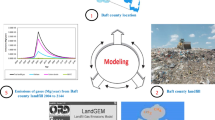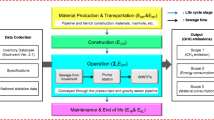Abstract
Purpose
The environmentally friendly construction of agricultural infrastructure is much needed for sustainable development because construction is recognized as a cause of environmental degradation. The objective of this study was to estimate and characterize carbon dioxide (CO2) emissions during construction of agricultural reservoir embankments for the quantitative environmental assessment and management of CO2 emissions using life cycle assessment method.
Methods
Two reservoirs with different foundation treatment and construction components were selected in this study and their characteristics in CO2 emissions were compared. And CO2 emissions were calculated separately for each of the following major components: construction materials, equipment, and transport. The basic unit of CO2 emissions for construction materials was calculated using the 2009 input–output tables in Korea and the basic unit of CO2 emissions for equipment of transport and construction was also calculated based on the amount of fuel used in a unit time.
Results and discussion
According to the study results, the construction of a water supply process appeared to generate the most emissions among all processes for the two sites. Emissions due to equipment were the highest in site A, while materials generated the most emissions in site B. Differences in emissions are due to differences in the construction process. While the operation time of the equipment in site A increased due to the cofferdam process and a large amount of cement was used in the foundation process in site B.
Conclusions
Characteristic of CO2 emissions differs with different construction processes and thus construction processes need to be optimized for environmental friendly development of agricultural infrastructure through estimation and characterization of CO2 emissions.







Similar content being viewed by others
References
Barrett S (1998) Political economy of the Kyoto Protocol. Oxf Rev Econ Policy 14:20–39
Bilec M, Ries R, Scott Matthews H, Sharrard AL (2006) Example of a hybrid life-cycle assessment of construction processes. J Infrastruct Syst 12(4):207–215
Borjesson P, Gustavsson L (2000) Greenhouse gas balances in building construction: wood versus concrete from life-cycle and forest land-use perspectives. Energ Policy 28(9):575–588
Deng L, Babbitt CW, Williams ED (2011) Economic-balance hybrid LCA extended with uncertainty analysis: case study of a laptop computer. J Clean Prod 19(11):1198–1206
Eaton KJ, Amato A (1998) A comparative life cycle assessment of steel and concrete framed office buildings. J Constr Steel Res 46(1–3):286–287
Erlandsson M, Borg M (2003) Generic LCA-methodology applicable for buildings, constructions and operation services-today practice and development needs. Build Environ 38:919–938
Fairbairn EMR, Ferreira LA, Cordeiro GC, Silvoso MM, Toledo FRD, Ribeiro FLB (2010) Numerical simulation of dam construction using low-CO2-emission concrete. Mater Struct 43:1061–1074
Flower DJM, Sanjayan JG (2007) Green house gas emissions due to concrete manufacture. Int J Life Cycle Assess 12:105–118
Gustavsson L, Joelsson A, Sathre R (2010) Life cycle primary energy use and carbon emission of an eight-storey. Energ Build 42:230–242
Harris DJ (1999) A quantitative approach to the assessment of the environmental impact of building materials. Build Environ 34:751–758
Hendrickson C, Horvath A, Joshi S, Lave L (1998) Economic input–output models for environmental life-cycle assessment. Environ Sci Technol 32(7):184A–191A
Hong T, Ji C, Park H (2012) Integrated model for assessing the cost and CO2 emission (IMACC) for sustainable structural design in ready-mix concrete. J Environ Manage 103:1–8
Intergovernmental Panel on Climate Change (2007) IPCC guidelines for National Greenhouse Gas Inventories. IGES, Kanakawa
ISO (2003) Environmental management—life cycle impact assessment—examples of application of ISO 14042. Geneva: International Organization for Standardization. ISO 14047:2003(E)
ISO (2006a) Environmental management—life cycle assessment—principles and framework. Geneva: International Organization for Standardization. ISO 14040:2006(E)
ISO (2006b) Environmental management—life cycle assessment—requirement and guidelines. Geneva: International Organization for Standardization. ISO 14044:2006(E)
Kim SH (2010) Direction of the four major rivers restoration project. Kor Cont Assoc 8:12–17 (in Korean)
Kim JY, Lee SE, Sohn JY (2004) An estimation of the energy consumption and CO2 emission intensity during building construction. Arch Inst Kor 20(10):319–326 (in Korean)
Korea Rural Community Corporation (2010) Business plan for an established business for the agricultural reservoir embankment elevation. Korea Rural Community Corporation (in Korean)
Korean institute of construction (2009) The standard estimating for construction works in 2009. Korean Institute of Construction, Seoul, Republic of Korea
Kwun SH, Kim SB (2007) The economic efficiency assessment of infrastructure considering environmental cost—a case study of emergency spillway for Korean multipurpose dam. Kor Inst Constr Eng Manag 8:168–176 (in Korean)
Lave L, Cobas-Flores E, Hendrickson C, McMichael F (1995) Using input–output analysis to estimate economy wide discharges. Environ Sci Technol 29(9):420A–426A
Lee JH, Jee YG, Lee TY, Shin HS, Kim SD (2011) Water resources system network building for climate change (II). Korea Environ Inst, Seoul, pp 108–111 (in Korean)
Leontief WW (1936) Quantitative input and output relations in the economic systems of the United States. Rev Econ Stat 18(3):105–125
Li Z (2006) A new life cycle impact assessment approach for buildings. Build Environ 41:1414–1422
Ortiz O, Castells F, Sonnermann G (2009) Sustainability in the construction industry: a review of recent developments based on LCA. Constr Build Mat 23:28–39
Park K, Hwang Y, Seo S, Seo H (2003) Quantitative assessment of environmental impacts on life cycle of highways. J Constr Eng Manag 129:25–31
Ramesh T, Prakash R, Shukla KK (2010) Life cycle energy analysis of buildings: an overview. Energ Build 42:1592–1600
Richard D, Hong T, Hastak M, Mirmiran A, Salem O (2007) Life-cycle performance model for composites in construction. Compos B: Eng 38:236–246
Rosenblum J, Horvath A, Hendrickson C (2000) Environmental implications of service industries. Environ Sci Technol 34(22):4669–4676
Rosselló-Batle B, Moià A, Cladera A, Martínez V (2010) Energy use, CO2 emissions and waste throughout the life cycle of a sample of hotels in the Balearic Islands. Energ Build 42:547–558
Seo SW, Hwang YW (1998) Life cycle CO2 assessment of residential building. Kor Soc Civ Eng 18(II-5):521–529, in Korean
Sharrard AL (2007) Green construction processes using an input-output-based hybrid life cycle assessment model. Ph.D. thesis Carnegie Mellon University, Pittsburgh
Sharrard AL, Matthews HS, Ries RJ (2008) Estimating construction project environmental effects using an input–output-based hybrid life-cycle assessment model. J Infrastruct Syst 14(4):327–336
Shrake SO, Bilec MM, Landis AE (2013) The application of a multi-faceted approach for evaluating and improving the life cycle environmental performance of service industries. J Clean Prod 42:263–276
Springer U (2003) The market for tradable GHG permits under the Kyoto Protocol: a survey of model studies. Energy Econ 25:527–551
Suh S (2006) Are services better for climate change? Environ Sci Technol 40(21):6555–6560
Suh S, Lenzen M, Treloar GJ, Hondo H, Horvath A, Huppes G, Jolliet O, Klann U, Krewitt W, Moriguchi Y, Munksgaard J, Norris G (2003) System boundary selection in life-cycle inventories using hybrid approaches. Environ Sci Technol 38(3):657–664
Suzuki M, Oka T (1998) Estimation of life cycle energy consumption and CO2 emission of office building in Japan. Energ Build 28:33–41
Tae S, Baek C, Shin S (2011a) Life cycle CO2 evaluation on reinforced concrete structures with high-strength concrete. Environ Impact Asses Rev 31:253–260
Tae S, Shin S, Woo J, Roh S (2011b) The development of apartment house life cycle CO2 simple assessment system using standard apartment houses of South Korea. Renew Sust Energ Rev 15:1454–1467
The Bank of Korea (2011) 2009 Input–output Tables. The Bank of Korea, Seoul, Republic of Korea (in Korean)
Thijs TR (2009) Input–output economics: theory and applications. Featuring Asian Economies, World Scientific, Singapore
Treloar GJ, Love PED, Crawford RH (2004) Hybrid life-cycle inventory for road construction and use. J Constr Eng Manag 130(1):43–49
Verbeeck G, Hens H (2010a) Life cycle inventory of buildings: a calculation method. Build Environ 45:1037–1041
Verbeeck G, Hens H (2010b) Life cycle inventory of buildings: a contribution analysis. Build Environ 45:964–967
Wisser D, Frolking S, Douglas EM, Fekete BM, Schumann AH, Vorosmarty CJ (2010) The significance of local water resources captured in small reservoirs for crop production—a global-scale analysis. J Hydro 30:264–275
Wu HJ, Yuan ZW, Zhang L, Bi J (2012) Life cycle energy consumption and CO2 emission of an office building in China. Int J Life Cycle Assess 17:105–118
Acknowledgments
This research was supported by Bio-industry Technology Development Program (no.111110-01-1), Ministry for Food, Agriculture, Forestry and Fisheries, Republic of Korea.
Author information
Authors and Affiliations
Corresponding author
Additional information
Responsible editor: Sangwon Suh
Rights and permissions
About this article
Cite this article
Noh, S., Son, Y., Bong, T. et al. Characterization of CO2 emissions during construction of reservoir embankment elevation in South Korea. Int J Life Cycle Assess 19, 42–51 (2014). https://doi.org/10.1007/s11367-013-0620-2
Received:
Accepted:
Published:
Issue Date:
DOI: https://doi.org/10.1007/s11367-013-0620-2




